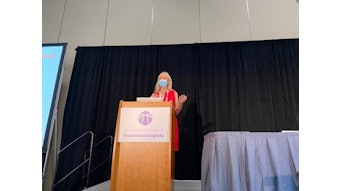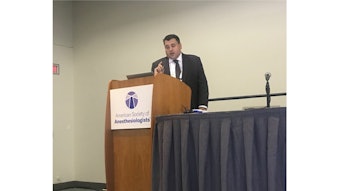Preventing intraoperative hypotension
Comparing absolute blood pressure thresholds with relative reduction from baseline to reduce intraoperative hypotension-associated harm.

Arterial intraoperative hypotension is associated with worse perioperative outcomes, including acute kidney injury (AKI), cardiac complications, myocardial injury, cognitive decline, delirium, longer hospital stay, and all-cause mortality. That’s according to Angela Selzer, MD, an Anesthesiologist with the University of Colorado Hospital in Aurora, and moderator of 2021's session “Absolute or Relative to Baseline: Is There a Magic Intraoperative Blood Pressure Number?”
“Maintaining a blood pressure intraoperatively may be the single most important way to manage perioperative patient outcomes,” Dr. Selzer said.
That much is clear. What’s less so is the actual definition of perioperative hypotension. It’s estimated that there are over 140 definitions of intraoperative hypotension in the literature.
“There’s no consensus agreement on what hypotension is and how we define it. What metric should we use to keep our patients’ blood pressure within limits – an absolute threshold or a percent reduction from baseline?” Dr. Selzer said.
In Sunday’s point-counterpoint, panelists presented evidence to support two opposing points of view: maintaining patients’ arterial intraoperative blood pressure relative to baseline or above an absolute threshold of mean arterial pressure (MAP).
“Strong evidence over the last decade supports an absolute MAP of at least 65-70 mmHg threshold for controlling blood pressure intraoperatively in the operating room,” said Ashish K. Khanna, MD, FCCM, FCCP,FASA Associate Professor of Anesthesiology & Vice-Chair for Research at Wake Forest School of Medicine in Winston Salem, North Carolina.
Citing the literature, Dr. Khanna presented strong evidence for an intraoperative blood pressure maintained at an absolute MAP greater than 65-70 mmHg.
“The amount of time spent under a MAP of 55 mmHg increases the risk of acute kidney injury, cardiac complications, and myocardial injury. A minute of hypotension happens all the time in the operating room,” he said. “Look at that signal and think about how much time our patients spend hypotensive on a daily basis, which increases the degree of harm.”
Patients are particularly vulnerable to hypotension during induction of anesthesia, he said.
“There’s typically a blood pressure drop in the peri-induction period. We can control not having peri-induction hypotension. We as anesthesiologists can truly make a difference,” Dr. Khanna said.
Recent data suggests a 25% reduction from baseline is associated with a similar degree of risk as an absolute threshold MAP of less than 65 mmHg. To avoid intraoperative hypotension, why not use baseline blood pressure as an intraoperative metric instead, Dr. Khanna asked?
“I’m not convinced a patient’s true baseline blood pressure is available in any case,” he said.
Preinduction blood pressure is not a patient’s true baseline, neither is the blood pressure measurement when in the preoperative clinic when patients are likely to be anxious, he said.
“Keep it simple. Think about a MAP of 65 to 70,” Dr. Khanna said. “Consistency of this signal across data sets has been published and has served the test of time.”
Presenting the counter argument, Kunal Karamchandani, MD, an Anesthesiologist with UT Southwestern in Dallas, said an intraoperative absolute threshold MAP of greater than 65-70 Hg mm goal was too simplistic.
“What about patients with coronary artery disease or those with chronically low blood pressure, such as patients with cirrhosis? One size does not fit all,” he said.
Dr. Karamchandani advocated for targeting an intraoperative blood pressure value tailored to each patient’s physiology, using ambulatory blood pressure data, and individualizing intraoperative blood pressure goals based on patients’ comorbidities and surgical context.
“Personalized blood pressure management is what makes sense. Patients should be able to tolerate the lowest normal blood pressure. If we could figure out a way to get this blood pressure, that would be money,” Dr. Karamchandani said.
Visit Anesthesiology Today Annual Meeting Edition for more articles.










![Sharks[2]](https://img.ascendmedia.com/files/base/ascend/hh/image/2021/10/Sharks_2_.616369899ebe1.png?auto=format%2Ccompress&bg=fff&fill-color=fff&fit=fill&h=191&q=70&w=340)
